After the deadliest mass shooting in Maine’s history, New England reporter Holly Ramer began looking for someone identified in police documents only as “Staff Sgt. Hodgson.” That person had earlier texted a superior in the U.S. Army that he was afraid Robert Card, a reservist, would “snap and do a mass shooting.” But officials downplayed the warning, calling Hodgson alarmist.
Ramer scoured Maine newspaper archives for any mention of the name and came across an arrest log that included a Sean Hodgson from Lewiston. That led her to social media profiles of a man wearing an Army uniform. She reached out.
Hodgson replied to Ramer’s initial message by referring her to an Army public affairs officer. She responded by sending him the police-commissioned report, in which his credibility was questioned, then asked him to meet. He called her shortly thereafter, which led to a series of interviews over the next week and a half.
From the start, Hodgson was upfront about his own personal failings and legal troubles, which David Sharp later confirmed at courthouses. But Hodgson felt strongly that his warning should have been taken more seriously, not only because of his training in threat mitigation but because of how well he knew Card through their 17-year friendship.
Hodgson had watched Card unravel, becoming increasingly angry and paranoid. Knowing Card had access to guns and wouldn’t get help, Hodgson raised the most glaring in a string of red flags concerning Card — he told authorities to change the passcode to the gate at their Army Reserve training facility and arm themselves if Card showed up.
The AP had the interview exclusively. Even after the AP story ran, Hodgson turned down multiple requests by other news agencies to talk. In a text message to Ramer, Hodgson said: “I really don’t want to go live or have interviews with other reporters. I just wanted to tell my side and that’s it. I believe I did that. Thank you.”
The story ran in outlets around the country. Nick Perry and Charlie Krupa provided strong, emotional text, audio and photos of shooting survivor Tammy Asselin, who reacted to the handling of the case. And Rodrique Ngowi brought all those elements together in a compelling video package that included Hodgson’s voice and an animation of the text messages he sent to warn officials.
For delivering a nuanced look at the many ways in which the situation could have been handled differently, which could have potentially saved 18 lives, Ramer is this week’s Best of AP — Second Winner.
Visit AP.org to request a trial subscription to AP’s video, photo and text services.
For breaking news, visit apnews.com.



